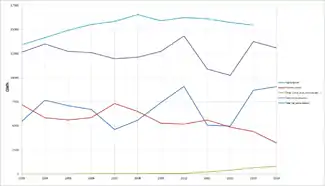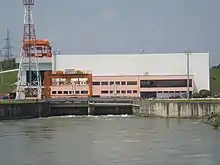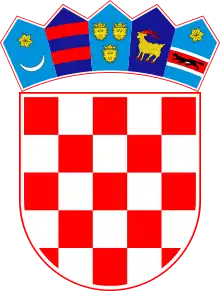Energy in Croatia
Energy in Croatia describes energy and electricity production, consumption and import in Croatia.
As of 2021, Croatia imported about 52.9% of the total energy consumed annually: 80% of its oil demand, 67% of its gas, 32.5 % of its electricity, and 100% of its coal needs.[1]
Croatia satisfies its electricity needs largely from hydro and thermal power plants, and partly from the Krško nuclear power plant, which is co-owned by Croatian and Slovenian state-owned power companies. Renewable energies account for approximately 28.5% of Croatia’s energy mix.[1]
Electricity
Hrvatska elektroprivreda (HEP) is the national energy company charged with production, transmission and distribution of electricity.
In 2020, electricity consumption totaled 16.1 terawatt-hours, which is about 11.7% less than in 2019.[2]
Production

Total installed capacity of generating objects built in Croatia amounts to 3,557 MW, 2,166 MW of which is hydropower and renewable sources share and 1,391 MW comes from thermal and nuclear power plants.[2]
In 2020, domestic production amounted to 12,510 GWh, which was 67% of total domestic demand. Remaining 33% was covered through trade. Total consumption equaled 18,660 GWh, a 10% decrease from 2019.[2]
Hydropower
Croatia has 28 hydropower plants of which 2 are reversible, 2 small size and 1 pumped storage. They are distributed in three production areas: North, West and South with one independent plant, and are HEP's most important source of renewable energy.[3]
| Hydropower plants | |||
|---|---|---|---|
| Name | Plum | Production capacity (MW) | Commissioned |
| HE Varaždin | Drava | 94.635 | 1975 |
| HE Čakovec | 77.44 | 1982 | |
| HE Dubrava | 79.78 | 1989 | |
| HE Rijeka | Rječina | 36.80 | 1968 |
| HE Vinodol | area of Gorski Kotar | 90.00 | 1952 |
| CHE Fužine | 4.50/-6.50 | 1957 | |
| RHE Lepenica | 0.80/-1.20 | 1985 | |
| HE Zeleni Vir | Kupa | 1.70 | 1921 |
| HE Senj | Lika and Gacka | 216.00 | 1965 |
| HE Sklope | Lika | 22.50 | 1970 |
| HE Gojak | Ogulinska Dobra and Zagorska Mrežnica | 56.00 | 1954 |
| HE Lešće | Donja Dobra | 42.29 | 2010 |
| HE Ozalj 1 | Kupa | 3.54 | 1908 |
| HE Ozalj 2 | 2.20 | 1952 | |
| RHE Velebit | Zrmanja | 276.00/-240.00 | 1984 |
| HE Miljacka | Krka | 20.00 | 1906 |
| MHE Krčić | 0.375 | 1988 | |
| HE Golubić | 6.54 | 1981 | |
| HE Jaruga | 7.20 | 1903 | |
| HE Peruća | Cetina | 60.00 | 1960 |
| HE Orlovac | Livanjsko Polje | 237.00 | 1973 |
| HE Đale | Cetina | 40.80 | 1989 |
| HE Zakučac | 538.00 | 1961 | |
| MHE Prančevići | 1.15 | 2017 | |
| HE Kraljevac | 46.4 | 1912 | |
| HE Dubrovnik | Trebišnjica | 126.00 | 1965 |
| HE Zavrelje | Zavrelje | 2.00 | 1953 |
Thermal energy
There are 7 thermal power plants of which 4 are also heating plants and one is combined cycle power plant.[4]
| Thermal power plants | |||
|---|---|---|---|
| Name | Fuel | Production capacity (MW) | Commissioned |
| TE Plomin | Stone coal | 199.00 | 1970 |
| TE Rijeka | Fuel oil | 303.00 | 1978 |
| KTE Jertovec | Natural gas and extra light fuel oil | 78.00 | 1954 |
| TE-TO Zagreb | Natural gas and gas oil | 300.00 | 1962 |
| EL-TO Zagreb | Natural gas and fuel oil | 50.00 | 1907 |
| TE-TO Osijek | Natural gas and fuel oil | 89.00 | 1985 |
| TE-TO Sisak | Natural gas and fuel oil | 228.73 | 1970 |
Bioenergy
Two biopower plants are now located in Croatia and both are also used for heating purposes.[5]
| Biopower plants | |||
|---|---|---|---|
| Name | Fuel | Production capacity (MW) | Commissioned |
| BE-TO Osijek | Woody biomass | 3.00 | 2017 |
| BE-TO Sisak | Woody biomass | 3.00 | 2017 |
Nuclear energy
Croatia has no nuclear power plants on its territory, but co-owns the Krško Nuclear Power Plant together with Slovenia. The Krško plant was built in the era of Yugoslavia on the territory of present-day Slovenia. Planned decommissioning is by 2043.[6]
| Nuclear power plants | |||
|---|---|---|---|
| Name | Fuel | Production capacity (MW) | Commissioned |
| NE Krško | Enriched uranium | 696.00 | 1983 |
Transmission
Croatian transmission grid consists of lines on three different rated voltage levels, namely 400, 220 and 110 kV. Total length of high-voltage lines is 7,795 km (4,843.59 mi) while length of medium and low voltage lines is 140,969 km (87,594.08 mi).[2]
The grid was often the target of attacks during Croatian War of Independence, resulting in frequent black-outs during the period. Since then, the grid has been repaired, and reconnected to synchronous grid of Continental Europe synchronous zones 1 and 2, making it an important transit system again.[7]
Distribution
Under the 2004 Energy law, customers in Croatia are allowed to choose their preferred distributor of electricity. However, HEP Operator distribucijskog sustava or HEP-ODS (a Hrvatska elektroprivreda subsidiary) remains the largest distributor to both industry and households. Its distribution grid is 141,568.6 km (87,966.65 mi) long, with 26 736 transformers installed, totaling 23,172 MVA of power.[8]
In 2020 there were 2,133,525 customers, 95.9% of which were households.[2]
Hydropower
With the implementation of the project HE Senj 2, HEP intends to use the remaining hydro potential in the Lika and Gacka basins by upgrading the existing hydropower system. The project involves the construction of a large reservoir and additional capacity in order to transfer production to the top of the daily chart. This will enable the capacity to inject high regulatory power into the power system with flexible hydro units ready for rapid power change. The construction of the hydroelectric power plant will cost 3.4 billion kuna and will have an installed capacity of 412 MW, while the construction deadline is 2028.[9]
Thermal power
In December 2019, the project of building a new high-efficiency combi-cogeneration unit KKE EL-TO Zagreb began, electric power 150 MW. The construction lasts for three years, and this project will replace part of the dilapidated and obsolete units at the EL-TO Zagreb location.[10]
Nuclear power
In 1978, the Adriatic island of Vir was selected as a location for a future nuclear power plant, but these plans were abandoned.[11]
According to reports, since 2009 Croatia has been discussing the option of building a nuclear power plant with Albania, in a location on the shore of Shkodër Lake, on the border with Albania and Montenegro. In April 2009 the Croatian government denied that any agreement had been signed.[12]
In a 2012 poll among 447 Croatian citizens, who were asked "Do you think it is justified to use nuclear energy for the production of electricity?", 42% answered "yes" and 44% answered "no".[13]
In 2021 the Slovenian government has issued an energy permit to GEN Energija for the planning and construction of the second unit of the Krško Nuclear Power Plant,followed by a statement by the Minister of Economy and Sustainable Development of Croatia Tomislav Ćorić that Croatia "will not look benevolently at the construction of the new bloc".[14] In March 2022, Plenković confirmed Croatia's readiness to enter the project of building the second block of the Krško NPP.[15]
Solar power
As of 2021, Croatia had 100 MW of solar power, providing 0.4% of electricity. The potential for solar energy in Croatia is estimated at 6.8 GW, of which 5.3 GW would be accounted for by utility-scale photovoltaic plants and 1.5 GW by rooftop solar systems.[16] Croatia plans to install 1.5 GW of solar capacity by 2024.[17]
See also
References
- "Croatia - Country Commercial Guide - Renewable Energy". 16 September 2021.
- "Izvješće o poslovanju i održivosti HEP grupe za 2020. godinu" [Report on operations and sustainability of the HEP Group for 2020] (PDF). HEP grupa (in Croatian). Hrvatska elektroprivreda. Retrieved 19 September 2021.
{{cite web}}: CS1 maint: url-status (link) - "Hidroelektrane" [Hydropower plants]. HEP Proizvodnja (in Croatian). Retrieved 30 March 2022.
- "Termoelektrane" [Thermal power plants]. HEP Proizvodnja (in Croatian). Retrieved 30 March 2022.
- "Bioelektrane" [Biopower plants]. HEP Proizvodnja (in Croatian). Retrieved 30 March 2022.
- Rotim, Goran (22 October 2021). "Hoće li se NE Krško produljiti vijek i dograditi?" [Will the Krško NPP be extended and upgraded?]. HRT (in Croatian). Retrieved 30 March 2022.
- http://www.hep.hr/ops/en/hees/default.aspx HEP Croatian power system
- "Godišnje izvješće 2020" [Annual report 2020] (PDF). HEP ODS (in Croatian). 2021. Retrieved 19 September 2021.
{{cite web}}: CS1 maint: url-status (link) - "Hidroenergetski sustav Senj 2" [Hydropower system Senj 2]. HEP grupa (in Croatian). Retrieved 31 March 2022.
- "KKE EL-TO Zagreb" [KKE EL-TO Zagreb]. HEP grupa (in Croatian). Retrieved 31 March 2022.
- "Rajski otok za divlju gradnju". Nacional (in Croatian). No. 441. 27 April 2004. Retrieved 30 October 2016.
- "Croatia Denies Nuclear Plant Contract". climatesceptics.org. 21 April 2009. Retrieved 9 April 2013.
- "Stav javnosti o potrebi izgradnje odlagališta radioaktivnog otpada u Republici Hrvatskoj" [Public opinion on necessity for construction of repository in the Republic of Croatia] (PDF). Rudarsko-geološko-naftni Zbornik (in Croatian). Faculty of Mining, Geology and Petroleum Engineering, University of Zagreb. 24 (1): 73–80. July 2012. Retrieved 30 October 2016.
- Oharek, Tomislav (22 July 2021). "Slovenci izdali dozvolu za novi blok nuklearke u Krškom, Austrijanci kipte od bijesa. A gdje je tu Hrvatska? Zasad - izvan igre" [Slovenians issued a permit for a new block of nuclear power plant in Krško, Austrians are boiling with rage. And where is Croatia? For now - out of the game]. tportal.hr (in Croatian). Retrieved 19 September 2021.
- "Plenković: Ako će se graditi novi blok Krškog, Hrvatska bi u tome participirala" [Plenković: If a new block of Krško is to be built, Croatia would participate in it]. N1 (in Croatian). 28 March 2022. Retrieved 31 March 2022.
- "Croatia's solar energy potential estimated at 6.8 GW". 4 March 2021.
- "Croatia to add 1.5 GW of renewables by 2025". 10 November 2021.

